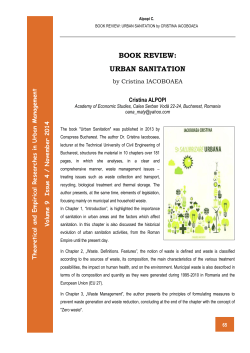
sustainable development of holy city ujjain, india by solid waste
SUSTAINABLE DEVELOPMENT OF HOLY CITY 127 Jr. of Industrial Pollution Control 21 (2)(2005) pp 127-132 © Enviromedia Printed in India. All rights reserved SUSTAINABLE DEVELOPMENT OF HOLY CITY UJJAIN, INDIA BY SOLID WASTE MANAGEMENT PARAG DALAL ”Adamya” 74 Kothi Road Ujjain- 456 010, M.P., India Key words :Solid Waste Management, Municipal Waste Management. ABSTRACT Our study results have established that from the social as well as commercial point of view. The envisaged project at Ujjain is not an economically and commercially feasible proportion owing to the low acceptable level of net present values and benefit cost ratio on different counts. Even the various alternatives worked out by us have not proved the system to be viable. In order to make the system feasible either the efficiency of the system has to be increased by improved technology or with the same technology to plan plant in the waste disposal site at Pandiakhedi so that the cost of project will be reduced. The Government should carefully examine the technical and social viabilities before setting any plant in the city or nearby areas. The socio-economic factor associated with MSW should be carefully examined by the planning masters. In our findings and field of observation, it is argued that there is a need to create awareness among the citizens and municipal officers about the environmental dimensions of the waste handling in the community. It is one of the most challenging tasks of the millennium to prevent the environmental disaster and subsequent health hazards. It is also true that sustainable approach of development depends on environmental and ecological tolerance, social acceptance and economic viability of any waste to energy project and other forms of waste management. In this context, I would like to suggest that municipal authorities, private enterprise, recycle traders, NGO’s and residents must be involved in the collection, waste transportation and disposal of solid waste. 128 SUSTAINABLE DEVELOPMENT OF HOLY CITY DALAL There should be a common platform where they meet discuss and share information to achieve a common goal that is green city and healthy city that’s UJJAIN. INTRODUCTION Solid waste managemnt issues- Large scale of migration into the cities due to socio-economic reason and the consequence increase in the population have created serious environmental problems in our urban areas including inadequate solid waste management. The traditional approach to solid waste management by the municipal authorities dealing with handling all aspects of collection, transportation and disposal has been at best a mixed success in both developed and the developing countries. An initiative towards the sound management of the environment was taken in the UN conference of environment and development 1992 held in Rio-de Janeiro, Brazil conference popularly known as “Rio Earth Summit”. The summit produces a strategic outlook for the 21st century or also known as Agenda 21 it had environmentally sound management of the solid waste and the sewage treatment issues. The Agenda 21 that deals with “Solid Waste Management Related issues” offers an integrated study of waste management and includes the following areas: (a) minimization of waste, (b) Promotion recycling and reuse, (c) Increasing service coverage and (d) Ensuring environmentally sound disposal. Sr. No. Types of Depots 129 No. of Depots 1. Cement and concrete rubbish depots 50 2. 8.5m3 Iron containers18 3. 6.53 Iron containers70 4. Up to m3 Iron containers300 5. Small concrete containers200 6. Open rubbish depot100 Secondary collection - Secondary collection is undertaken in two parts of UNN. While the department is responsible for secondary collection, transportation, the disposal of waste while the second one has Engineering Department dealing with maintenance. The persons employed are Sanitary inspector – 4, Sanitary supervisor – 9, Driver – 13, Motor filler - 98 These persons work in Freegunj, 2 city 3 Agar roads, 4 Maksi roads. Sr. No. Type of Vehicle Numbers 1.Loader5 2.Tripper15 3.Dumper 9big)1 4.Dumper (small)5 5.Tractors5 6.DCM2 7.JCB2 8.R.C. (big)1 9.R.C. (small)1 Survey on the practices of solid waste management in Ujjain.- In the previous various aspects related to management practice are adopted by developing countries and developed countries have been discussed. In this chapter and a turn has been made to examine the present management practice of solid waste in the city, which is in order to assess the present management practice in Ujjain. Disposal of solid waste in Ujjain Role of UNN in primary, secondary and solid waste collection and disposal. The collection of solid waste is being done in two phases. The solid waste is collected and dumped in Pandiakhedi (the landfill site). At present no treatment is done because of high cost i.e., Rs.30 per metric ton. In order to streamline the solid waste management in the class 2 cities of India the Supreme Court of India has appointed a committee to study the various problems of management in different cities. On the basis of the recommendation of the committee, the Supreme Court has fixed a time schedule for implementing different important activities and laid down norms and standards of output of the sanitary Staff. After considering the objections, the rules were finalized and published for implementation from 26 September 2000(Municipal solid waste mangement and handling rules) and till now these rules are in operation. These rules apply to every authority responsible for collection, segregation, storage, transportation, processing and disposal of the municipal Solid waste. Every municipal authority shall, within the territorial area of the municipality, will be responsible for the implementation of the provision of these rules, and also for any infrastructure development Primary collection - in the primary collection the waste is collected in hand carts and carried to the rubbish depot, primary collection centers from where it is carried to different disposal sites by opened trucks, tractors, trippers, etc. The city is divided in to six zones covering 54 wards in the city from management point of view. There are about 150 collection points in the city. Collection of waste is a relatively modernized in 50 centers in the rest 100 the collection practices are very poor. Mainly the UNN involve manpower in the collection of solid waste. As per the scheduled the sweepers start working yet seven am and the female sweepers at 8:30 am till 11 ‘o clock. Their attendance is then taken by Daroga. The second half scheduled of work is till 15:00 hrs. The sweepers have to the foot path, roads and drains and the make smaller heaps of the garbage and poured them in to wheel barrow. Waste collection points - their are 2 different wastes storage facilities in Ujjain. Our field survey shows that the disposal of municipal waste in Ujjain Nagar Nigam is haphazard. Any other newly developed colonies do not have any collection point or sweeper so the collection of waste in their colonies is a major problem. Also the garbage of slum is highly unorganized. And the people living near these areas were highly affected by the different diseases. 130 SUSTAINABLE DEVELOPMENT OF HOLY CITY DALAL 131 for collection, storage, segregation, transportation, processing, and disposal of solid waste. Problems in handling/ managing solid waste in Ujjain Inefficient primary waste collection system The chief officer is primarily responsible for managing solid wastes. He has help from four zonal health offices. These officers, being medically doctors by profession, they usually lack proper training in solid waste management. they are quite unaware of the latest developments and the modern technology of solid waste handling. These doctors are also responsible for the maintenance of hygiene in the municipal area by checking food adulteration, vaccination, maintaining the birth and death registers and other health related services. We have survey that about 30 percent of the posts are vacant in Health department. Poor storage facility Waste collected through the primary device needs to be temporarily stored before being transported to the landfill sites. In Ujjain small containers of waste are been taken and or failed on a large truck in depots. We have about 10 different depots all over the city. At many places the condition of the road was not good for the movement of transport. The numbers of containers provided in the residential area are fewer than required so. Households often dumped wastes in vacant plots nearby. Solid waste generation per day Problems with secondary collection Composition of waste source in residential area The Freegunj Department looks after the second recollection and disposal of the solid waste. Different types of transportation systems are used, ranging from open trucks, containers, carrying vehicles, loaders and landfill vehicles. On an average about 40 percent of the collection vehicles are used, 20 percent of the vehicles are not utilized and are due for repairs and maintenance. Lack of equipment and tools Numbers of handcarts are inadequate in relation to the number of sweepers. These are shared by 3-4 sweepers. also the trolleys and the cranes with sufficient trucks and JCB‘s are lacking. Commericla areas Vegetable market Poor organization and that governance There is a very little communication between the Health department, cleaning up department and UNN. So the face a large amount of problem between themselves and also cause trouble to the people. Financial problems Te budget of UNN is about rupees 1360 lakhs per annum on solid waste management practice. 10 per cent goes as wages and salaries, 70 percent goes towards the primary collection, 5 per cent towards the secondary collection, 10 percent on fuel and rest on the maintenance and other costs including the repair. Eating places Temples 132 DALAL Lack of public apathy The government of India (2000) and the Supreme Court (1999) has recognized that public apathy towards pollution is a major problem towards waste management. No one comes forward to ask about unauthorized dumping and improper disposal of solid wastes. Political problems The solid waste management problems are further aggravated due to the lack of political commitments. Political leaders have failed to deliver and on other hand they make fabulous schemes by which they can earn a lot of profit for themselves. Waste characterization: our field survey Various aspects related to management practices of MSW in Ujjain city have been discussed. As it is the part of scope of our work, it has been investigated to analyze the composition of solid waste generated from different sectors within Ujjain. We have characterized the Solid waste to cover the following aspects: To assess the type of waste generated at the source and the disposal point. This will help to understand the material loss, material recycled and the attitude of the people in recycling the material and the type of the material rejected. To assess the composition of waste source and to identify the bio degradable as well as combustible matter. For the feasibility of lifting material and for power generation. To assess the recyclable values of the waste and the amount of waste in the transition. It is assessed for calculating the revenue generated from recycled goods. To assess the characterization of MSW to identify the quality of hazardous wastes generated and the disposal along with the MSW at the final disposal site. REFERENCES Centrak Pollution Control Board. 2000. Management of Municipal Solid Waste.CPCB, New Delhi ICDP, 2002. Solid Waste Management in Kanpur .Technical Report. ICDP, 2. Strategic action plan for municipal solid waste management in Ujjain. MOEF 1987, 1989 and 2000. Environmental Protection Act. MOEF, New Delhi.
© Copyright 2025









